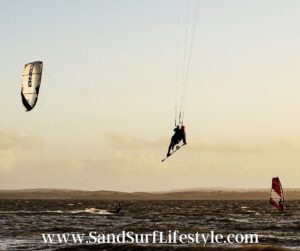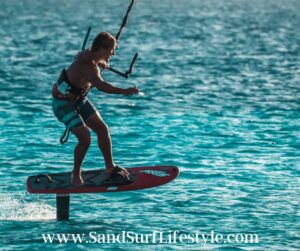Kitesurfing and surfing are both very exciting water sports that are filled with thrills and excitement, but both of these sports have steep learning curves. So which of the two is easier to learn for beginners?
What is kitesurfing?
 Kitesurfing is an exciting sport in which the rider uses the power of the wind to carry themselves along the surface of the water just as a surfer would.
Kitesurfing is an exciting sport in which the rider uses the power of the wind to carry themselves along the surface of the water just as a surfer would.
To harness the power of the wind in this case, kitesurfers use giant kites to catch the wind effectively.
The sport is said to bottom elements from a wide variety of other extreme sports including paragliding, surfing, windsurfing, snowboarding, and wakeboarding.
What are the difficulties with kitesurfing?
Now that we have an idea as to what kitesurfing is and the history behind it, let’s take a look at some of the difficulties that come with kitesurfing.
Weak Winds:
Trying to learn to kitesurf with weak winds is much harder than learning it when strong winds are present.
This is because weak winds make trying to kitesurf very technically requiring very specific techniques and skills to prevent you from dropping the kite.
Because of this, learning to kitesurf when weak winds are present is very difficult and can further complicate the process.
Complicated water conditions:
Water is rarely predictable, especially when it comes to the ocean.
Choppy water, high waves, complicated currents, as well as other water conditions make learning to kitesurf that much more difficult.
This is because while traditional surfing does rely heavily on waves, kitesurfing relies on the wind, and having weather conditions that are less than perfect can make learning more complicated than it needs to be.
Coordination:
 As with every other sport, having good coordination is going to be very important when it comes to how successful you are going to be.
As with every other sport, having good coordination is going to be very important when it comes to how successful you are going to be.
However, unlike other sports, kitesurfing relies more heavily on coordination than it does on pure strength or any other attribute.
This reliance on coordination can make learning kitesurfing even more difficult when you have to balance on the board as well.
Equipment:
While the kitesurfing equipment is nowhere close to as expensive as the equipment for some other water sports, it can be a bit difficult to deal with.
For one, the equipment in kitesurfing can be a bit difficult to get into the water, especially for beginners.
On top of that, if you aren’t completely sure how to hook the equipment up safely and effectively, it is pretty unlikely that you will end up getting the results that you are hoping for.
As you spend more time kitesurfing, you will get better at handling the equipment. But for beginners, this may be one of the more difficult things you will have to figure out.
Is kitesurfing actually easier than surfing?
After the last section talking about all the difficulties that are involved with learning to kitesurf, you may still be questioning whether kitesurfing is easier than surfing.
The answer is still yes, kitesurfing is easier than surfing for most people.
Both of these water sports have a steep learning curve, requiring a lot of work to be put in before you can consider yourself a surfer of any sort.
But those who choose to learn to kitesurf will generally find themselves out in the water faster than those who choose traditional surfing.
Is kitesurfing expensive? Find out here.
What makes kitesurfing easier?
There two main factors that make kitesurfing easier for most people than
1. More accessible conditions:
Traditional surfing has very specific weather conditions that it needs for you to be able to effectively practice. One of these conditions is that the water has to have good enough waves to ride on.
In surfing, you are chasing waves to give you the thrill that you are looking for.
But in many instances, waves fit for surfing are kind of difficult to come by.
In kitesurfing, however, you are not as worried about the waves which mean you are going to have many more instances where you can get out onto the water.
 Another important aspect of the weather conditions that you have to keep in considerations is wind levels.
Another important aspect of the weather conditions that you have to keep in considerations is wind levels.
In kitesurfing, winds are your friend, the faster the winds are the more fun you are going to have. In surfing, however, strong winds can make your experience much more difficult.
On the water, winds are fairly common and likely, making it much more likely that you will be able to kitesurf more frequently than you would be able to try traditional surfing.
2. The physical conditioning necessary:
Surfing requires you to be in pretty great shape for you to be able to stand and balance on the board.
Kitesurfing however doesn’t have the same physical requirements.
This is because, in surfing, you are simply relying on yourself to stand and balance while the board is moving quite uncontrollably, which requires a great amount of core and lower body strength.
Surfing also requires you to be able to lift yourself onto the board, which is often a more difficult task than it may seem.
Kitesurfing however does not require you to be in as great of shape because you can use the kite to help you balance on the board.
What are the steps when learning to kitesurf?
While we’ve established that kitesurfing is easier than surfing, it doesn’t mean that kitesurfing isn’t difficult to learn.
In reality, yes, it is a bit difficult to learn, but it’s not impossible.
We’re going to take a look at some of the steps that you take when learning to kitesurf.
1. Learn to use the equipment
The equipment you use when kitesurfing can be a bit tricky to use, so it’s usually the first thing that instructors teach when they are instructing beginning kitesurfers.
This usually takes a few hours, but once you understand how to use the equipment, you are in a great position to get started.
2. Flying the kite on land
This step can be taught before or after the first step, but it is crucial if you are planning to kitesurf, as using the kite is the center point of the sport itself.
 3. Practicing balance on the board
3. Practicing balance on the board
While balance isn’t as important as it may be when traditional surfing, it’s still a pretty important step in learning to kitesurf.
There are several different ways in which you can practice balancing on the board. One way is to use a skateboard and to try balancing on that.
Whatever you can do to practice your balance is a great step toward kitesurfing.
4. Practice out in the water
At some point, you are going to have to get out in the water and practice with the actual equipment that you will be using when kitesurfing.
This is the point where you can do that! Good luck and have fun!
The history of kitesurfing:
Kitesurfing first came into existence a little over 40 years ago in the year 1977.
A Dutch man by the name of Gijsbertus Adrianus Panhuise obtained the first patent for kitesurfing in that year.
The original patent described the sport as “a water sport using a floating board of a surfboard type where a pilot standing up on it is pulled by a wind catching device of a parachute type tied to his harness on a trapeze type belt”
Kitesurfing began achieving high levels of popularity in the 1990s.
Its popularity was partly because it was and still is one of the least expensive and most convenient of all of the water sailing sports.
This has to do with the fact that kitesurfing doesn’t require a lot of equipment to do.
You truly only need the board, the kite, and the harness.
This relatively small amount of equipment means that you can travel with the equipment fairly easily and that you won’t need to spend thousands upon thousands of dollars for something like a sailboat.
The sport truly took off however in 1998 when the first kitesurfing event took place in Maui Hawaii.
From there, the sport has become fairly mainstream so if you don’t do it or even if you don’t know someone else who does, chances are you still know what the sport is and what it looks like.
Please note: This blog post is for educational purposes only and does not constitute legal or medical advice. Please consult a legal expert or medical professional to address your specific needs.

